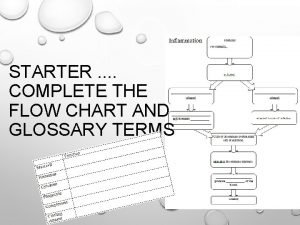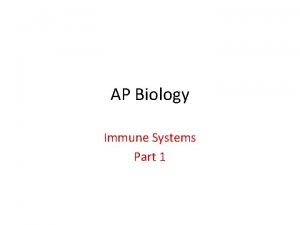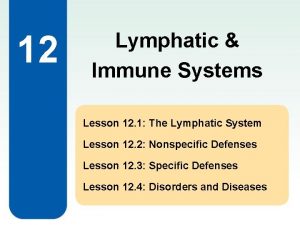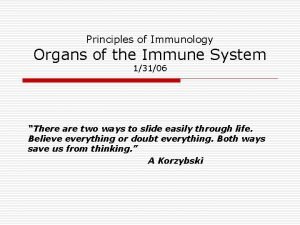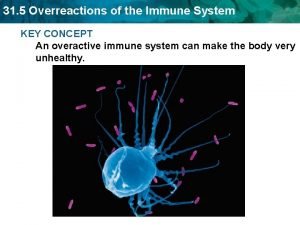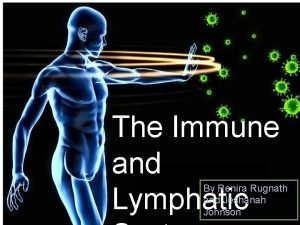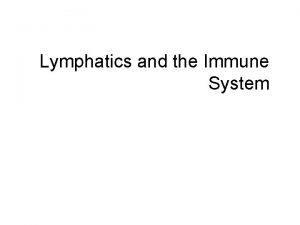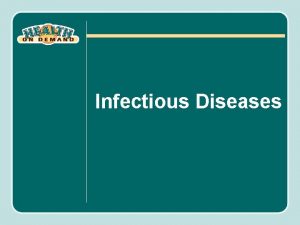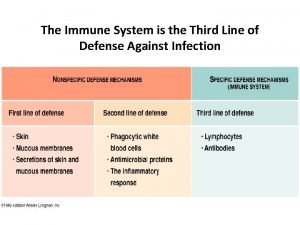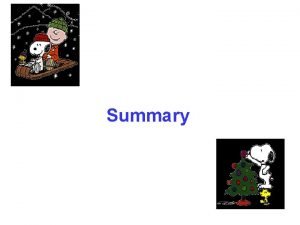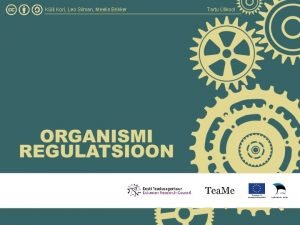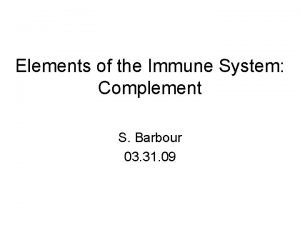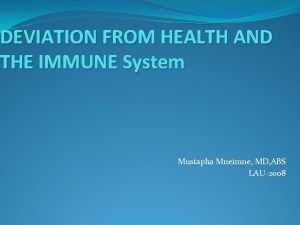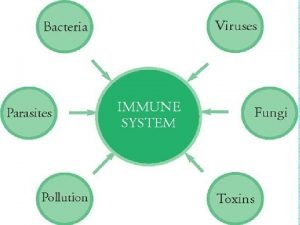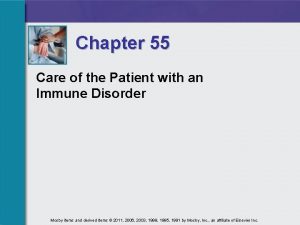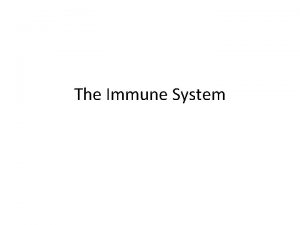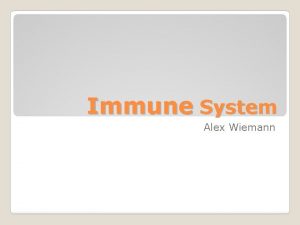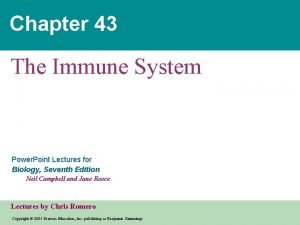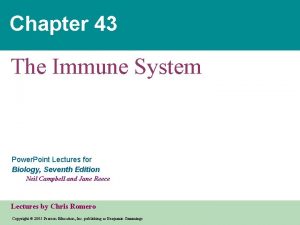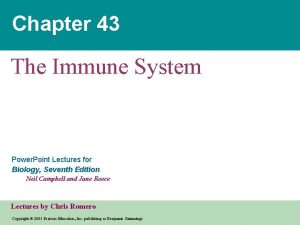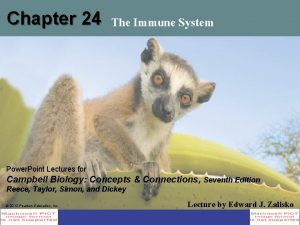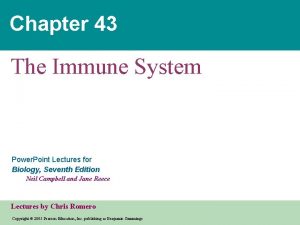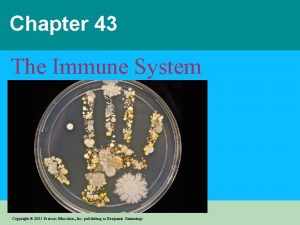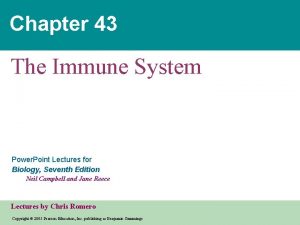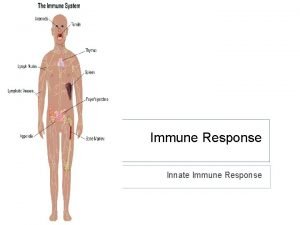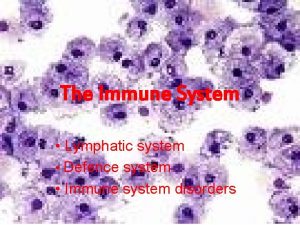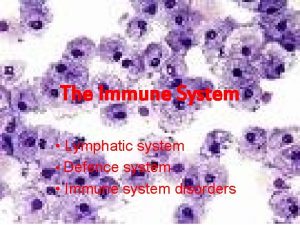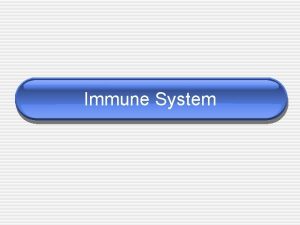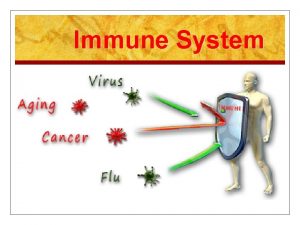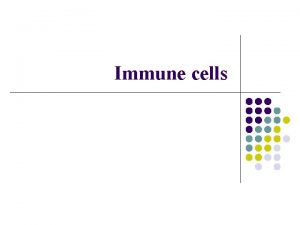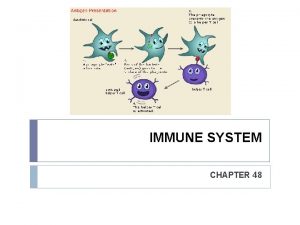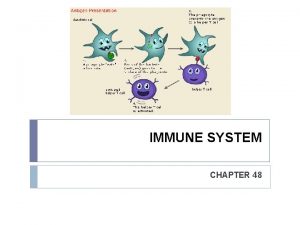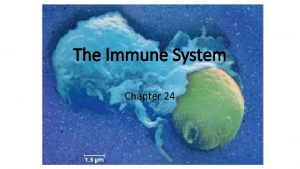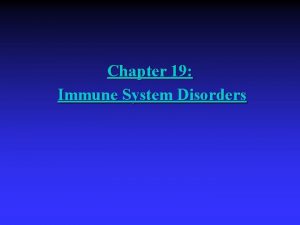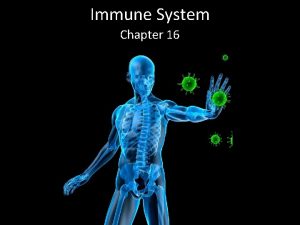Chapter 24 The Immune System Power Point Lectures




































- Slides: 36

Chapter 24 ���The Immune System Power. Point Lectures for Biology: Concepts and Connections, Fifth Edition – Campbell, Reece, Taylor, and Simon Lectures by Chris Romero Copyright © 2005 Pearson Education, Inc. Publishing as Benjamin Cummings

An AIDS Uproar • Acquired immune deficiency syndrome (AIDS) – Is epidemic throughout much of the world • Thousands of people are infected every day Copyright © 2005 Pearson Education, Inc. Publishing as Benjamin Cummings

• HIV, the virus that causes AIDS, attacks the immune system – And eventually destroys the body’s ability to fight infection Copyright © 2005 Pearson Education, Inc. Publishing as Benjamin Cummings

INNATE DEFENSES AGAINST INFECTION 24. 1 Innate defenses against infection include the skin and mucous membranes, phagocytic cells, and antimicrobial proteins • Innate immunity – Is present and effective long before exposure to pathogens Copyright © 2005 Pearson Education, Inc. Publishing as Benjamin Cummings

• Microbes that breach the body’s external defenses Colorized SEM 3, 800 – Are engulfed and destroyed by macrophages Figure 24. 1 A Copyright © 2005 Pearson Education, Inc. Publishing as Benjamin Cummings Bacteria

• Interferons are proteins produced by virus-infected cells – That help other cells resist viruses Viral nucleic acid Antiviral proteins block viral reproduction 1 2 Interferon genes turned on New viruses DNA m. RNA 3 5 Interferon molecules Figure 24. 1 B ���� Host cell 1 Makes interferon; is killed by virus Copyright © 2005 Pearson Education, Inc. Publishing as Benjamin Cummings Interferon stimulates cell to turn on genes for antiviral proteins 4 Host cell 2 ���� Protected against virus by interferon from cell 1

24. 2 The inflammatory response mobilizes nonspecific defense forces • Tissue damage triggers the inflammatory response Pin�� Skin surface Swelling Bacteria Phagocytes and fluid move into area Chemical signals Phagocytes White blood cell Blood vessel 1 Tissue injury; release of chemical signals such as histamine 2 Dilation and increased leakiness of local blood vessels; migration of phagocytes to the area Figure 24. 2 Copyright © 2005 Pearson Education, Inc. Publishing as Benjamin Cummings 3 Phagocytes (macrophages and neutrophils) consume bacteria and cell debris; tissue heals

• The inflammatory response – Can disinfect tissues and limit further infection Copyright © 2005 Pearson Education, Inc. Publishing as Benjamin Cummings

24. 3 The lymphatic system becomes a crucial battleground during infection • The lymphatic system – Is a network of lymphatic vessels and organs Adenoid Tonsil Lymph nodes Right lymphatic duct, entering vein Thoracic duct, entering vein Lymph node Masses of lymphocytes and macrophages Thymus Valve Thoracic duct Lymphatic vessel Blood capillary Tissue cells Appendix Bone marrow Figure 24. 3 Copyright © 2005 Pearson Education, Inc. Publishing as Benjamin Cummings Spleen Interstitial fluid Lymphatic vessels Lymphatic capillary

• The vessels collect fluid from body tissues – And return it as lymph to the blood • Lymph organs such as the spleen and lymph nodes – Are packed with white blood cells that fight infections Copyright © 2005 Pearson Education, Inc. Publishing as Benjamin Cummings

ACQUIRED IMMUNITY 24. 4 The immune response counters specific invaders • Our immune system – Responds to foreign molecules called antigens • The immune system reacts to antigens – And “remembers” an invader Copyright © 2005 Pearson Education, Inc. Publishing as Benjamin Cummings

• We can temporarily acquire passive immunity – By receiving “premade” antibodies • Infection or vaccination – Triggers active immunity Figure 24. 4 Copyright © 2005 Pearson Education, Inc. Publishing as Benjamin Cummings

24. 5 Lymphocytes mount a dual defense • Two kinds of lymphocytes carry out the immune response – – B cells secrete antibodies that attack antigens T cells attack cells infected with pathogens Bone marrow Thymus Stem cell Via blood Immature lymphocyte Antigen receptors T cell Cell-mediated immunity B cell Humoral immunity Via blood Lymph nodes, spleen, and other lymphatic organs Other parts of the lymphatic system Figure 24. 5 A Copyright © 2005 Pearson Education, Inc. Publishing as Benjamin Cummings Final maturation of B and T cells in lymphatic organ

• Millions of kinds of B cells and T cells, each with different membrane receptors Figure 24. 5 B Copyright © 2005 Pearson Education, Inc. Publishing as Benjamin Cummings Colorized TEM 4, 500 – Wait in the lymphatic system, where they may respond to invaders

24. 6 Antigens have specific regions where antibodies bind to them • Antigenic determinants – Are the specific regions on an antigen to which antibodies bind Antibody A molecules Antigenbinding sites ���Antigenic determinants ���Antigen molecule Figure 24. 6 Antibody B molecule Copyright © 2005 Pearson Education, Inc. Publishing as Benjamin Cummings

24. 7 Clonal selection musters defensive forces against specific antigens • When an antigen enters the body – It activates only a small subset of lymphocytes with complementary receptors Copyright © 2005 Pearson Education, Inc. Publishing as Benjamin Cummings

• The selected lymphocyte cells multiply into clones of short-lived effector cells – Specialized for defending against the antigen that triggered the response Copyright © 2005 Pearson Education, Inc. Publishing as Benjamin Cummings

The Steps of Clonal Selection • In the primary immune response, clonal selection – Produces effector cells and memory cells that may confer lifelong immunity • In the secondary immune response – Memory cells are activated by a second exposure to the same antigen, which initiates a faster and more massive response Copyright © 2005 Pearson Education, Inc. Publishing as Benjamin Cummings

• The primary and secondary immune responses Primary immune response 1 2 Antigen receptor (antibody on cell surface) Antigen molecules B cells with different response 3 First exposure antigen Cell activation: growth, division, and differentiation Antibody molecules 4 5 5 Endoplasmic reticulum Clone of memory cells Plasma (effector) cells secreting antibodies Antigen molecules 6 Second exposure to same antigen Secondary immune Antibody molecules response Figure 24. 7 A Endoplasmic reticulum Plasma (effector) cells secreting antibodies Copyright © 2005 Pearson Education, Inc. Publishing as Benjamin Cummings Clone of memory cells

Primary vs. Secondary Immune Response • The primary immune response – Is slower than the secondary immune response Antibody concentration Second exposure to antigen X, first exposure to antigen Y First exposure to antigen X Primary immune response to antigen Y Antibodies to X Figure 24. 7 B Secondary immune response to antigen X 0 7 14 Copyright © 2005 Pearson Education, Inc. Publishing as Benjamin Cummings 21 28 Time (days) 35 42 49 56

24. 8 Antibodies are the weapons of humoral immunity • Antibody molecules – Are secreted by plasma (effector) B cells Figure 24. 8 A Copyright © 2005 Pearson Education, Inc. Publishing as Benjamin Cummings

• An antibody molecule – Has antigen-binding sites specific to the antigenic determinants that elicited its secretion Antigen-binding sites V V C C C Figure 24. 8 B Copyright © 2005 Pearson Education, Inc. Publishing as Benjamin Cummings C Heavy chain Light chain

24. 9 Antibodies mark antigens for elimination • Antibodies promote antigen elimination – Through several mechanisms Binding of antibodies to antigens inactivates antigens by Neutralization (blocks viral binding sites; coats bacteria) Agglutination of microbes Activation of Complement system Complement molecule Bacteria Virus Antigen molecules Bacterium Figure 24. 9 Precipitation of dissolved antigens Foreign cell Enhances Leads to Phagocytosis Cell Iysis Macrophage Copyright © 2005 Pearson Education, Inc. Publishing as Benjamin Cummings Hole

CONNECTION 24. 10 Monoclonal antibodies are powerful tools in the lab and clinic • Monoclonal antibodies – Are produced by fusing B cells specific for a single antigenic determinant with easy to grow tumor cells Antigen injected into mouse B cells (from spleen) Tumor cells grown in culture Tumor cells Cells fused to generate hybrid cells Single hybrid cell grown in culture Antibody Figure 24. 10 A Hybrid cell culture, producing monoclonal antibodies Copyright © 2005 Pearson Education, Inc. Publishing as Benjamin Cummings

• These molecules – Are useful in research, diagnosis, and treatment of certain cancers Copyright © 2005 Pearson Education, Inc. Publishing as Benjamin Cummings

24. 11 Helper T cells stimulate humoral and cellmediated immunity • Helper T cells and cytotoxic T cells – Are the main effectors of cell-mediated immunity • Helper T cells – Also stimulate the humoral responses Copyright © 2005 Pearson Education, Inc. Publishing as Benjamin Cummings

• In cell-mediated immunity, an antigenpresenting cell – Displays a foreign antigen and one of the body’s own self proteins to a helper T cell Copyright © 2005 Pearson Education, Inc. Publishing as Benjamin Cummings

• The helper T cell’s receptors – Recognize the self-nonself complexes and the interaction activates the helper T cells • The helper T cell – Can then activate cytotoxic T cells and B cells Copyright © 2005 Pearson Education, Inc. Publishing as Benjamin Cummings

• The activation of a helper T cell and its roles in immunity Self-nonself complex Microbe B cell T cell receptor Interleukin-2 stimulates cell division Macrophage 5 3 1 Humoral Immunity (secretion of antibodies by plasma cells) 6 Helper T cell 2 7 4 Interleukin-2 activates other B cells and T cells Self protein Antigen from microbe (nonself molecule) Antigen-presenting cell Interleukin-1 stimulates helper T cell Figure 24. 11 Copyright © 2005 Pearson Education, Inc. Publishing as Benjamin Cummings Binding site for antigen Binding site for self protein Cytotoxic T cell Cell-mediated immunity (attack on infected cells)

CONNECTION 24. 12 HIV destroys helper T cells, compromising the body’s defenses • The AIDS virus attacks helper T Cells Opening the way for opportunistic infection Figure 24. 12 Copyright © 2005 Pearson Education, Inc. Publishing as Benjamin Cummings Colorized EM 7, 000 –

24. 13 Cytotoxic T cells destroy infected body cells • Cytotoxic T cells – Bind to infected body cells and destroy them 1 Cytotoxic T cell binds to infected cell Self-nonself complex 2 Perforin makes holes in infected cell’s membrane and enzyme enters Hole forming Foreign antigen Infecte cell Perforin molecule Cytotoxic T cell Enzyme that can promote apoptosis Figure 24. 13 Copyright © 2005 Pearson Education, Inc. Publishing as Benjamin Cummings 3 Infected cell is destroyed

24. 14 Cytotoxic T cells may help prevent cancer • Cytotoxic T cells may attack cancer cells Figure 24. 14 Copyright © 2005 Pearson Education, Inc. Publishing as Benjamin Cummings Colorized SEM 4, 370 – Which have abnormal surface molecules

24. 15 The immune system depends on our molecular fingerprints • The immune system – Normally reacts only against nonself substances, not against self – May reject transplanted organs because these cells lack the unique “fingerprint” of the recipient’s self proteins Copyright © 2005 Pearson Education, Inc. Publishing as Benjamin Cummings

DISORDERS OF THE IMMUNE SYSTEM CONNECTION 24. 16 Malfunction or failure of the immune system causes disease • In autoimmune diseases – The system turns against the body’s own molecules • In immunodeficiency diseases – Immune components are lacking, and frequent infections recur • Physical and emotional stress – May weaken the immune system Copyright © 2005 Pearson Education, Inc. Publishing as Benjamin Cummings

CONNECTION 24. 17 Allergies are overreactions to certain environmental antigens • Allergies – Are abnormal sensitivities to antigens (allergens) in the surroundings Copyright © 2005 Pearson Education, Inc. Publishing as Benjamin Cummings

• The two stages of an allergic reaction B cell (plasma cell) Mast cell Antigenic determinant 1 Allergen (pollen grain) enters blood stream Histamine 2 B cells make antibodies 3 Antibodies attach to mast cell 4 Sensitization: Initial exposure to allergen Copyright © 2005 Pearson Education, Inc. Publishing as Benjamin Cummings 5 Histamine is released, causing allergy symptoms Later exposure to same allergen 3 Figure 24. 17 Allergen binds to antibodies on mast cell Antibodies attach to mast cell
 A subsequent
A subsequent Power system lectures
Power system lectures Chapter 35 immune system and disease
Chapter 35 immune system and disease What is the third line of defense in the immune system
What is the third line of defense in the immune system Complete the flow chart
Complete the flow chart Any substance capable of provoking an immune response
Any substance capable of provoking an immune response 1st line of defense immune system
1st line of defense immune system Primary vs secondary immune response
Primary vs secondary immune response Ap bio immune system
Ap bio immune system Lesson 12.1 lymphatic ducts and vessels
Lesson 12.1 lymphatic ducts and vessels Lesson 12 blood and immune system
Lesson 12 blood and immune system Immune system lymph nodes
Immune system lymph nodes Immune system definition
Immune system definition Overreactions of the immune system
Overreactions of the immune system Lymphatic vs immune system
Lymphatic vs immune system Phagocitize
Phagocitize Defination of immune system
Defination of immune system 2nd line of defence
2nd line of defence Main function of the immune system
Main function of the immune system Waldeyer's ring
Waldeyer's ring Thymus immune system
Thymus immune system Immune complex
Immune complex Thessalamia
Thessalamia 1what's the purpose of the body's immune system?
1what's the purpose of the body's immune system? Chapter 55 care of the patient with an immune disorder
Chapter 55 care of the patient with an immune disorder Chapter 24 the immune and lymphatic systems and cancer
Chapter 24 the immune and lymphatic systems and cancer What empties into the left subclavian vein
What empties into the left subclavian vein Triangle of power
Triangle of power Power bi power point
Power bi power point Point point power
Point point power Rick trebino
Rick trebino Neonatology lectures
Neonatology lectures Data mining lectures
Data mining lectures Advanced medicinal chemistry
Advanced medicinal chemistry Orthopedic ppt lectures
Orthopedic ppt lectures Ludic space
Ludic space Activity planning in software project management
Activity planning in software project management




